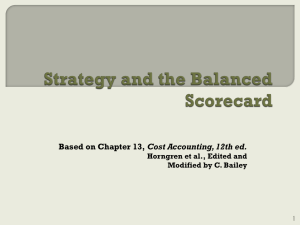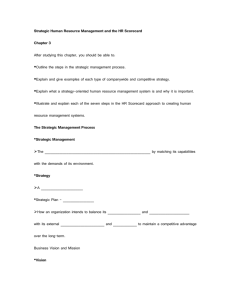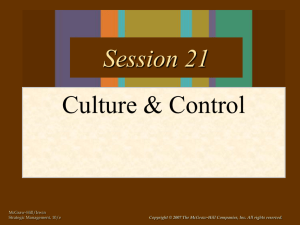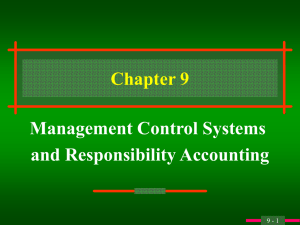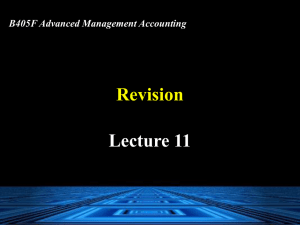Strategy, Balanced Scorecard and Strategic Profitability Analysis
advertisement
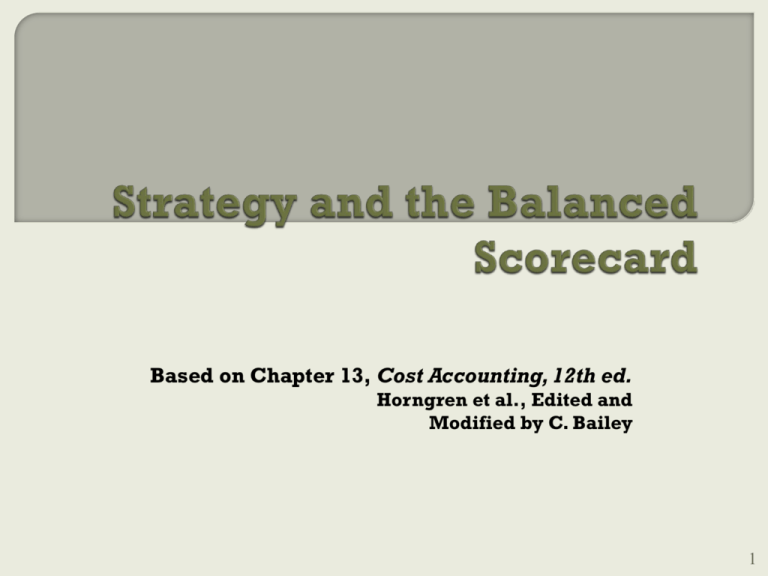
Based on Chapter 13, Cost Accounting, 12th ed. Horngren et al., Edited and Modified by C. Bailey 1 This topic… • explores the use of management accounting information for implementing and evaluating an organization’s strategy. • shows how MA information helps strategic initiatives: productivity improvement reengineering downsizing. 2 Strategy describes how an organization matches its own capabilities with the opportunities in the marketplace to accomplish its overall objectives. In formulating its strategy, an organization must thoroughly understand the industry in which it operates. 3 Industry 1 analysis focuses on five forces: Competitors • Reducing prices of products is critical for any industry to grow. • Competition today is severe along the dimensions of price, timely delivery, and quality. 4 2 Potential entrants into the market • Competition usually keeps profit margins small. • Existing companies probably have lower costs. • Existing companies also have the advantage of close relationships with customers. 5 3 Equivalent products • How easily can users substitute other products (consider MS Windows!) 4 Bargaining power of customers • Customers may obtain the products from other potential suppliers. 6 5 Bargaining power of input suppliers • Suppliers of high-quality materials can demand higher prices. • Skilled engineers, technicians, and laborers can demand higher wages. 7 Two 1 2 generic strategies that organizations use are: Product differentiation Cost leadership 8 Customers perceive product/service to be superior and unique relative to competitors. • Hewlett Packard in the electronics industry • Merck in the pharmaceutical industry • Coca-Cola in the soft drinks industry • Others? 9 Achieving low costs relative to competitors. How? • Productivity and efficiency improvements • Elimination of waste • Tight cost control – Examples? • Dell, Bic 10 To be successful, a company must • formulate an effective strategy • implement it vigorously. Management accountants play important role • collecting meaningful data • designing reports to help managers track progress in implementing strategy. 11 The balanced scorecard translates an organization’s mission and strategy into a comprehensive set of performance measures. Does not focus solely on financial objectives. • highlights nonfinancial objectives that an organization must achieve to meet its [longterm] financial objectives. 12 Attempts to balance • financial and nonfinancial performance measures • short-run and long-run performance in a single report. Why does the balanced scorecard reduce manager’s emphasis on short-run financial performance? 13 Reduces short-term emphasis because: • nonfinancial and operational indicators measure fundamental changes • financial benefits of these changes may not appear in short-run earnings. • nonfinancial measures (leading indicators) signal the prospect of creating economic value in the future. 14 There are four perspectives of the balanced scorecard: 1 Financial perspective 2 Customer perspective 3 Internal business process perspective 4 Learning and growth perspective 15 Evaluates the profitability of the strategy. Focuses on how factors affect income: • Growth (units sold, inputs need) • Price Recovery (higher prices, lower costs) • Productivity (efficiency of resource use) 16 Objective: Increase shareholder value Sample Measures: – Increase in operating income – Revenue growth – Cost reduction is some areas – Return on investment SALES – 17 Identifies the targeted market segment and measures the company’s success in these segments. 18 – – – – Market share Customer satisfaction Customer retention percentage Time taken to fulfill customers requests 19 Focuses on internal operations • Create value for customers • Further the financial perspective by increasing shareholder wealth. Typical Objectives: • Improve manufacturing capability • Reduce delivery time to customers • Meet specified delivery dates 20 Innovation Process Manufacturing capabilities Number of new products or services New product development time Number of new patents – 21 Operations Process Yield Defect rates Time taken to deliver product to customers Percentage of on-time delivery Setup time Manufacturing downtime – 22 Post-sales service Time taken to replace or repair defective products Hours of customer training for using the product – 23 Emphasizes capabilities of • Employees empowerment, training • Info systems Typical Objectives: Develop process skill Empower work force Enhance information system capabilities 24 – – – – – Employee education and skill level Employee satisfaction scores Employee turnover rates Information system availability Percentage of processes with advanced controls 25 1 2 It tells the story of a company’s strategy by articulating a sequence of cause-andeffect relationships. It assists in communicating the strategy to all members of the organization by translating the strategy into a coherent and linked set of measurable operational targets. 26 3 4 5 In for-profit companies, the balanced scorecard places strong emphasis on financial objectives and measures. The scorecard limits the number of measures used by identifying only the most critical ones. The scorecard highlights suboptimal tradeoffs that managers may make. 27 1 2 3 Don’t assume the cause-and-effect linkages to be precise. Don’t seek improvements across all measures all the time. Don’t use only objective measures on the scorecard. 28 4 5 Don’t fail to consider both costs and benefits of initiatives such as spending on information technology and research and development. Don’t ignore nonfinancial measures when evaluating managers and employees. 29 End of BSC Presentation 30
